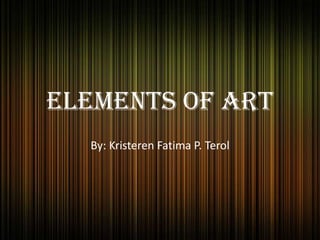
Elements of Art
- 1. Elements of Art By: Kristeren Fatima P. Terol
- 2. Art It is the product or process of deliberately arranging items in a way that influences and affects one or more of the senses, emotions, and intellect. The elements of art are the building blocks used by artists to create a work of art.
- 3. 7 Elements of Art • Line • Shape • Form • Value • Texture • Color • Space
- 4. Line • a mark that is made on a surface or outline. • defined by a point moving in space. • Can be two-or threedimensional, descriptive, implied, or Abstract.
- 5. 5 main kinds of line A. Horizontal Line • Lines that run parallel to the ground B. Vertical Line • Lines that move up and down.
- 6. C. Diagonal Line D. Curved Line • Lines that slant. • Lines that change direction gradually.
- 7. E. Zigzag line • Lines that are made by combining diagonal lines that change direction. • These lines when viewed in a work of art create confusion. They suggest action and excitement.
- 8. Shape • It has always two dimensions, length as well as width. • It is represented as an enclosed area that is defined by color, value, space, texture and form. • When lines form together, they make flat shapes.
- 9. Categories of Shapes A. Geometric Shapes • Also called as regular shapes. • These are shapes that are easy to recognize and is use in math information also.
- 10. B. Organic Shapes • Also called as freeform shapes • These are shapes that seem to follow no rules. • Figures that have a natural look and a flowing, curving appearance.
- 11. C. Positive Shapes D. Negative Shapes • It is the solid forms • It is the space in a design around the positive shape. • Occupy positive space. (The positive space is masked by black.) (The negative space is masked by black.)
- 12. E. Static Shape F. Dynamic Shape • It appears stable and resting. • It appears as if moving and active.
- 13. Form • Has always three dimensions; length, width and height.
- 14. Types of Form A. Cube • A regular solid of six equal square sides. B. Cylinder • A surface traced by a straight line moving parallel to a fixed straight line and intersecting a fixed planar closed curve.
- 15. C. Cone D. Sphere • A solid generated by • A round solid figure, rotating a right or its surface, with triangle about one of every point on its its legs. surface equidistant from its center.
- 16. Value • Refers to the changes in the base color. • Range of lightness and darkness within a picture.
- 17. Categories of Value A. Tint B. Shade • Adding white to color • Adding black to paint paint to create lighter to create dark values values such as light such as dark blue or blue or pink. dark red.
- 18. C. High-Key D. Low-Key • Where the picture • Where the picture is all light values. is all dark values.
- 19. E. Value Contrast F. Value Scale • Where light values • A scale that shows are placed next to the gradual change in dark values to create value from its lightest contrast or strong value, white to its differences. darkest value black.
- 20. Texture • The quality of a surface or the way any work of art is represented. • Also refers to the way a picture is made to look rough or smooth. Categories of Texture • Real Texture • Implied Texture
- 21. color • Has three characteristics, which are hue, value and intensity. • Hue means the shades (red, yellow or pink) • Value refers to the lightness or the darkness. • Intensity refers to the brightness or dullness of the work of art.
- 22. Space • It is the creation of visual perspective; this gives the illusion of depth. • It can also mean the way an artist uses the area within the picture plane. • Real space is actually three-dimensional.